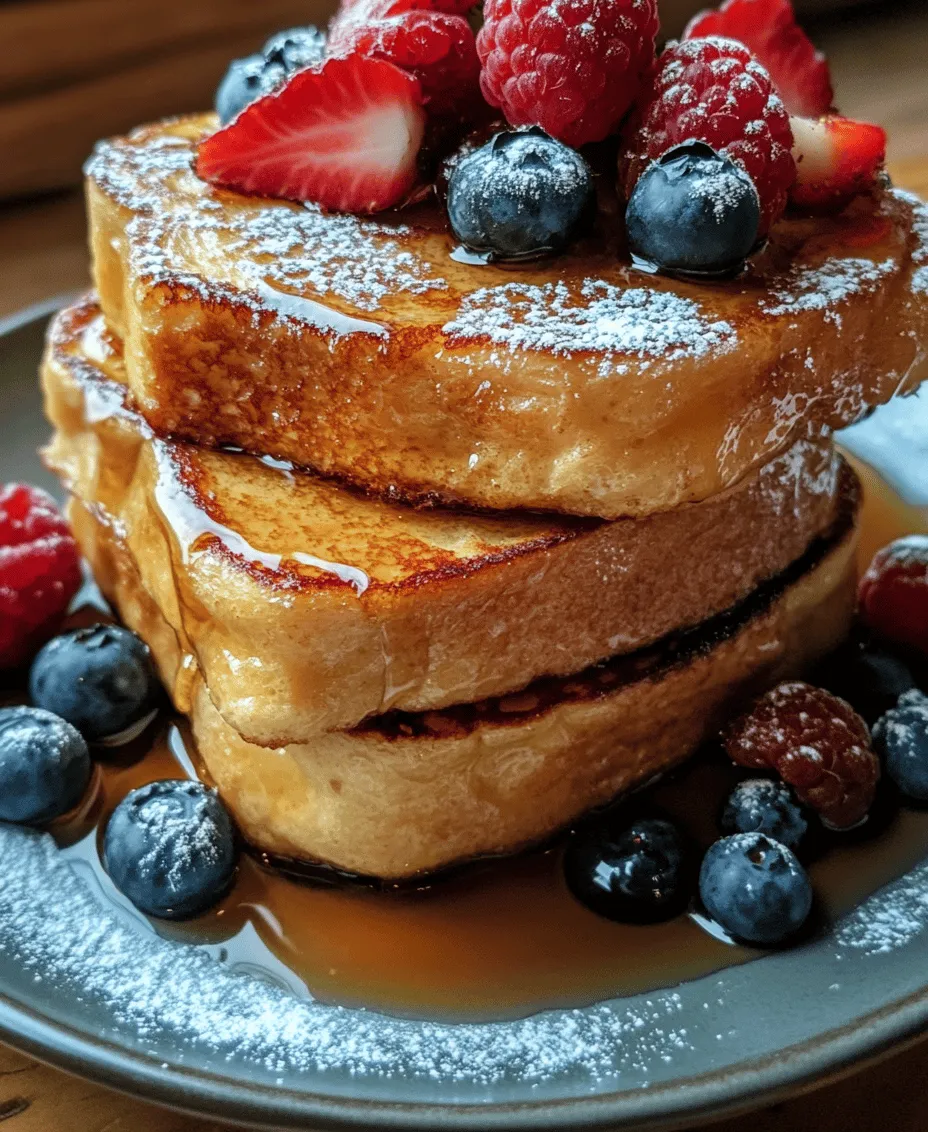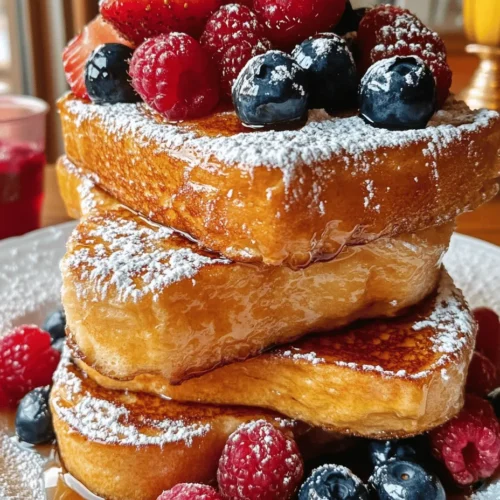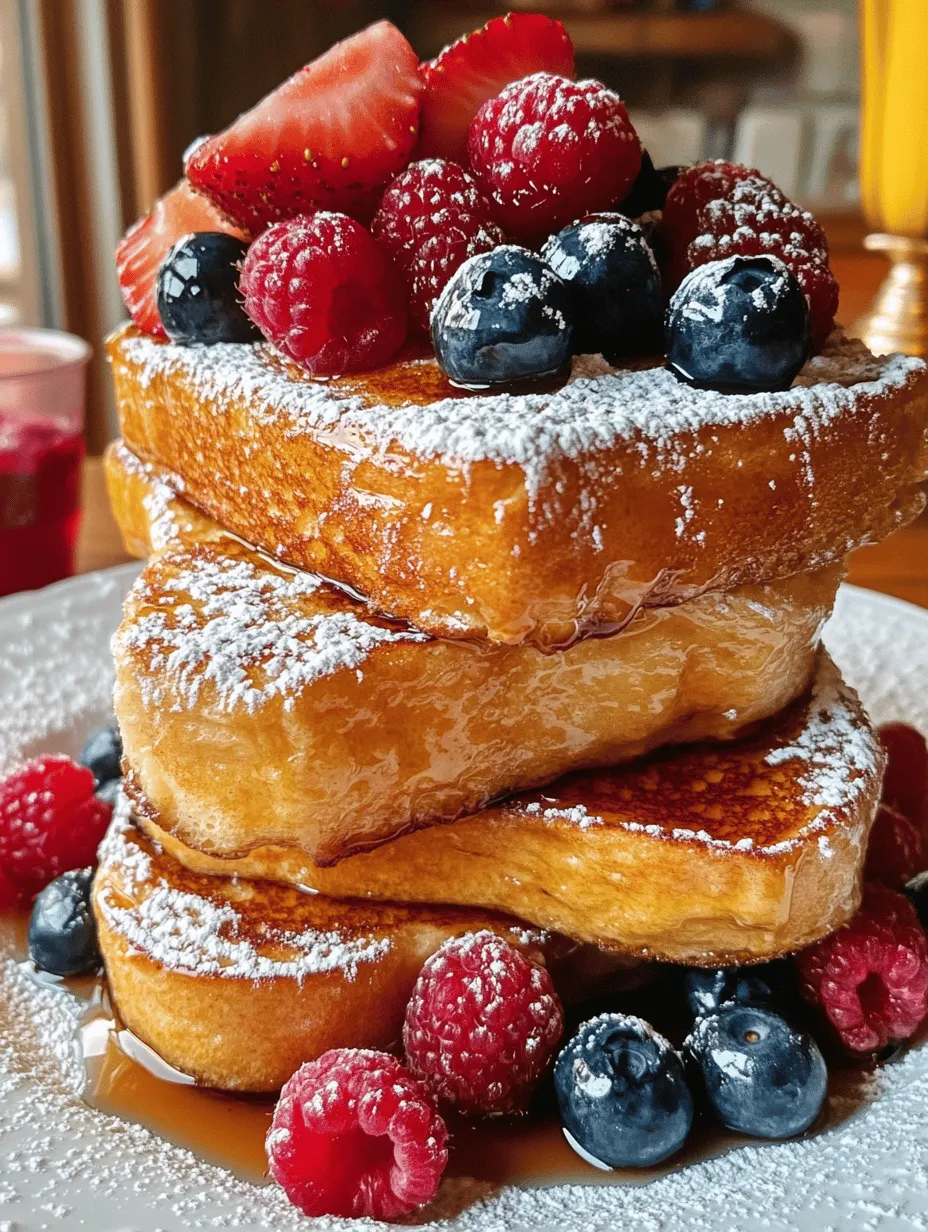Introduction
French toast is more than just a breakfast dish; it’s a nostalgic experience that transports many of us back to carefree mornings filled with the warm aroma of sizzling bread, the sweetness of syrup, and the joy of sharing a meal with loved ones. Its versatility allows for endless variations, yet the classic version remains a staple in households around the world. What sets apart a truly delightful French toast from a mediocre one is not only the method of cooking but also the quality of ingredients used.
Today, we invite you to discover the recipe for Perfectly Fluffy French Toast Delight. This recipe emphasizes the importance of using high-quality ingredients to achieve the ultimate flavor and texture, ensuring that each bite is a heavenly experience. With a few simple steps, you can turn ordinary bread into an extraordinary breakfast that will impress family and friends alike.
The Allure of French Toast
French toast has a rich history that spans centuries and cultures. Its origins can be traced back to ancient times, with variations appearing in Roman and medieval cuisines. The concept of soaking stale bread in a mixture of eggs and milk to prevent waste has been embraced by diverse cultures, leading to a variety of regional adaptations. From the savory pain perdu of France to the sweet eggy bread of the United States, French toast continues to be a beloved dish around the globe.
What keeps French toast at the forefront of breakfast menus is its comforting nature and the sheer joy it brings to the table. The fluffy texture combined with rich flavors makes it the perfect canvas for toppings, whether you prefer fresh fruits, maple syrup, or a dusting of powdered sugar. The allure of perfectly fluffy French toast lies in its ability to evoke warmth and satisfaction, making it a timeless favorite for breakfast, brunch, or even dessert.
Choosing the Right Bread
When it comes to making the best French toast, the choice of bread is paramount. Not all breads are created equal; the right type can significantly enhance the dish’s flavor and texture. For a perfectly fluffy French toast experience, we recommend using either brioche or challah.
Brioche is a rich and buttery bread that offers a delicate, airy texture. Its soft crumb absorbs the egg and milk mixture beautifully, creating a custard-like interior that complements the crisp exterior once cooked. The slight sweetness of brioche also adds a delightful dimension to the dish.
Challah, on the other hand, is a traditional Jewish bread known for its braided appearance and slightly sweet flavor. It has a sturdy structure that holds up well during the soaking process, making it an excellent choice for French toast. The density of challah allows it to absorb the custard mixture without falling apart, resulting in a satisfying bite.
When selecting bread for your French toast, look for loaves that are slightly stale, as they will absorb the custard more effectively without becoming soggy. If your bread is fresh, you can simply leave it out for a few hours before preparing the dish, or lightly toast it to achieve the perfect balance of moisture and texture.
Ingredients Breakdown
Understanding the role of each ingredient in the recipe not only enhances your cooking skills but also helps you appreciate the art of making French toast. Here’s a detailed look at the essential components of our Perfectly Fluffy French Toast Delight.
Eggs
Eggs are the cornerstone of a classic French toast recipe. They act as the binding agent, bringing together the other ingredients and adding structure to the dish. The proteins in eggs coagulate during cooking, contributing to the fluffy texture we all crave. Additionally, eggs provide richness and a beautiful golden color once cooked, elevating the dish’s visual appeal.
Whole Milk
The creaminess of whole milk plays a crucial role in the custard mixture for French toast. It enhances the richness of the dish while ensuring that the bread absorbs enough moisture without becoming overly soggy. Whole milk provides a velvety texture that enriches the flavor profile, making each bite indulgent and satisfying. For those looking for alternatives, you can substitute with almond milk or oat milk for a dairy-free option, but be sure to choose unsweetened varieties to maintain the balance of flavors.
Vanilla Extract
Vanilla extract is the secret ingredient that adds depth and complexity to your French toast. Its warm, sweet aroma complements the richness of the eggs and milk while infusing the dish with a comforting flavor. A splash of vanilla extract is all it takes to transform your French toast from ordinary to extraordinary.
Ground Cinnamon
The addition of ground cinnamon is what elevates the flavor of French toast to another level. This warm spice brings a delightful aromatic quality that pairs beautifully with the sweetness of the bread and custard mixture. Cinnamon also has the added benefit of being a natural antioxidant, making your breakfast not only delicious but also a bit healthier. Feel free to adjust the amount of cinnamon to your taste, or experiment with other spices such as nutmeg or cardamom for a unique twist.
Sugar
Sugar is essential for balancing the flavors in your French toast, contributing to both sweetness and caramelization. When cooked, sugar enhances the browning process, resulting in a beautifully golden crust that adds a delightful crunch to each bite. You can choose to use granulated sugar, brown sugar for a deeper flavor, or even maple syrup to sweeten the custard mixture. Just be cautious not to overdo it—too much sugar can overshadow the other flavors and make the dish overly sweet.
With these ingredients in mind, you are now equipped to create your Perfectly Fluffy French Toast Delight. The careful selection and combination of these elements will ensure that you achieve a breakfast that is not only satisfying but also a true culinary delight. In the next section, we will delve into the step-by-step instructions for making this delicious dish, guiding you through the process of transforming simple ingredients into a breakfast masterpiece.

Butter: Essential for Cooking and Flavor Enhancement
Butter is a crucial component in achieving the perfect French toast. Not only does it provide rich flavor, but it also contributes to that sought-after golden crust. When you melt butter in your skillet, it creates a wonderful aroma that elevates your cooking experience. Opt for unsalted butter to allow better control over the seasoning. Additionally, consider using a blend of butter and a splash of oil to prevent burning while still achieving a crispy exterior. This combination ensures that your French toast is not only flavorful but also perfectly cooked without drastic temperature fluctuations.
Maple Syrup and Garnishes: Elevating the Presentation and Taste
While French toast is delicious on its own, the right toppings can take it to the next level. Maple syrup is a classic choice, providing sweetness that complements the richness of the dish. To elevate your presentation, drizzle warm maple syrup over your French toast just before serving. You can also sprinkle a dusting of powdered sugar for a touch of elegance.
Consider garnishing with fresh mint leaves or a sprinkle of cinnamon for added color and flavor. If you want to get creative, top your French toast with candied pecans or walnuts for a delightful crunch. Not only do these garnishes enhance the appearance of your dish, but they also add layers of flavor that can transform a simple breakfast into a gourmet experience.
Step-by-Step Instructions
Preparing the Batter: Importance of Whisking for Texture
Begin by preparing your batter, which is the heart of any good French toast. In a large mixing bowl, combine your eggs, milk, vanilla extract, and a pinch of salt. The key to a smooth and well-mixed batter lies in proper whisking. Whisk vigorously until the mixture is well combined, and the eggs are fully incorporated. This process introduces air into the batter, resulting in a lighter and fluffier French toast. For an added depth of flavor, consider incorporating a splash of almond extract or a sprinkle of nutmeg into the batter.
Soaking the Bread: Techniques to Ensure Optimal Absorption Without Sogginess
Once your batter is ready, it’s time to soak the bread. Choose thick slices of bread, such as brioche or challah, as they hold up well during the soaking process. Dip each slice of bread into the batter, allowing it to absorb the mixture for about 30 seconds on each side. Be careful not to over-soak, as this can lead to soggy French toast. Aim for a balance where the bread is saturated yet retains its structure.
Cooking Method: Achieving the Perfect Golden-Brown Crust
Now that your bread is prepped, it’s time to cook. Heat a non-stick skillet or griddle over medium heat and add a generous pat of butter. Once melted and bubbling, gently place the soaked bread slices into the skillet. Cook for about 3-4 minutes on each side or until golden brown. Avoid overcrowding the pan, as this can lower the temperature and lead to uneven cooking. If necessary, work in batches to ensure each slice gets the attention it deserves.
Pay attention to the edges of the bread; a perfectly cooked French toast should be firm yet slightly crispy on the outside while remaining soft and fluffy on the inside. Adjust the heat as needed to prevent burning, and remember that patience is key when cooking.
Serving Suggestions: Creative Ways to Present French Toast for Maximum Appeal
Once your French toast is cooked to perfection, it’s time to present it beautifully. Stack two or three slices on a plate, and drizzle with warm maple syrup. For an added touch of sophistication, consider dusting with powdered sugar or adding a dollop of whipped cream. You can also create a layered effect by alternating slices with fresh fruits like banana or strawberries, adding both visual appeal and freshness.
For a fun twist, consider serving your French toast as a sandwich, with layers of peanut butter and banana or cream cheese and strawberries. This not only enhances the flavor but also adds an element of surprise for your guests.
The Perfect Pairings
Exploring Delicious Toppings Beyond Traditional Maple Syrup
While maple syrup is a beloved classic, there are numerous creative toppings you can explore to complement your French toast. Try drizzling some honey or agave syrup for a different sweetness profile. Homemade berry compote is another fantastic option, offering vibrant flavors that enhance your breakfast experience.
Fresh Fruit: Benefits of Adding Berries for Flavor and Nutrition
Adding fresh fruit to your French toast is not only visually appealing but also nutritious. Berries like blueberries, raspberries, and strawberries can be a delightful addition, providing a burst of flavor and antioxidants. Simply toss them on top of your French toast or serve them on the side. You can also make a quick fruit salad to accompany your dish, adding a refreshing contrast to the richness of the toast.
Whipped Cream and Flavored Syrups: How They Enhance the Dish
Whipped cream can add a luxurious touch to your French toast. For an extra flavor boost, consider infusing your whipped cream with vanilla or almond extract. Flavored syrups, such as caramel or chocolate, can also provide a decadent twist. Drizzle these syrups over your French toast or serve them in small bowls for dipping.
Nut Butters and Chocolate Spread: Unique Twists to Excite Taste Buds
For those looking to add a unique twist, consider spreading a layer of nut butter, such as almond or hazelnut, between slices of French toast. This not only adds a delightful nutty flavor but also provides healthy fats and protein. Alternatively, a chocolate spread can turn your French toast into a dessert-like treat, especially when paired with sliced bananas or strawberries.
Nutritional Information
Breakdown of Calories and Nutrients Per Serving
Understanding the nutritional content of your French toast can help you make informed choices. A typical serving of French toast (two slices) made with whole eggs and whole milk can contain around 350-400 calories, depending on the toppings. It also provides a good source of protein and carbohydrates, making it a satisfying breakfast option.
Healthier Alternatives for Specific Ingredients (e.g., Dairy-Free Options)
If you’re looking to lighten up your French toast, consider using egg whites or a flaxseed mixture as a substitute for whole eggs. For a dairy-free version, almond milk or oat milk can work wonders in the batter without sacrificing flavor. Whole grain or gluten-free bread can also be used for a healthier alternative that adds fiber to your meal.
Balancing Indulgence with Nutritious Choices
While French toast is a delightful indulgence, you can balance pleasure with nutrition by incorporating fresh fruits and opting for natural sweeteners. This way, you can enjoy a delicious breakfast that also supports your overall well-being.
Conclusion
There is truly something special about making and sharing Perfectly Fluffy French Toast Delight. This dish embodies the comfort and joy of breakfast, offering a canvas for creativity with various toppings and flavors. Each bite brings a wave of nostalgia, reminding us of leisurely mornings spent with loved ones.
I encourage you to experiment with different variations and toppings to find your perfect combination. Whether you prefer traditional maple syrup or adventurous flavors like nut butter and fresh fruit, the possibilities are endless. This dish is not just about nourishment; it’s about creating memories and sharing moments around the breakfast table. So, gather your ingredients, embrace the cooking process, and enjoy the satisfaction of serving this delightful dish to family and friends.



